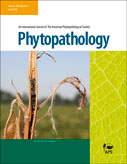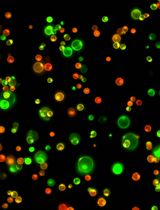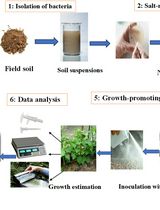- EN - English
- CN - 中文
An Innovative Approach to Study Ralstonia solanacearum Pathogenicity in 6 to 7 Days Old Tomato Seedlings by Root Dip Inoculation
一种通过根部浸渍接种研究6-7天番茄幼苗青枯雷尔氏菌致病性的新方法
发布: 2018年11月05日第8卷第21期 DOI: 10.21769/BioProtoc.3065 浏览次数: 7470
评审: Samik BhattacharyaMahmoud Kamal AhmadiAnonymous reviewer(s)
Abstract
Ralstonia solanacearum (F1C1) is a Gram-negative plant pathogenic bacterium that causes lethal wilt disease in a wide range of plant species. This pathogen is very well known for its unpredictable behavior during infection and wilting its host. Because of its mysterious infection behavior, virulence and pathogenicity standardization are still a big challenge in the case of R. solanacearum. Here, we report an innovative pathogenicity assay of R. solanacearum (F1C1) in the early stage of tomato seedlings by root dip inoculation. In this assay, we employed 6-7days old tomato seedlings for infection grown under nutrients free and gnotobiotic condition. After that, pathogenicity assay was performed by maintaining the inoculated seedlings in 1.5 or 2 ml sterile microfuge tubes. During infection, wilting symptom starts appearing from ~48 h post inoculation and the pathogenicity assay gets completed within seven days of post inoculation. This method is rapid, consistent as well as less resource dependent in terms of labor, space and cost to screen large numbers of plants. Hence, this newly developed assay is an easy and useful approach to study pathogen virulence functions and its interaction with the host plant during wilting and disease progression at the seedling stage.
Keywords: Ralstonia solanacearum (青枯雷尔氏菌)Background
Bacterial wilt pathogen Ralstonia solanacearum dwells in soil. When favorable condition comes, the bacterium enters inside the suitable host plant through root, grows, colonizes there and ultimately kills the plant. R. solanacearum strain (F1C1) had been isolated and characterized from a wilted chilli plant nearby Tezpur (Assam), north-east India (Kumar et al., 2013). Owing to the lethality and its exceptional wide host range, R. solanacearum considered as the second most devastating bacterial phytopathogen around the world (Mansfield et al., 2012). In spite of that, no effective approach so far is available to deal with this pathogen and its associated disease.
Regarding its virulence and pathogenicity assay, several existing methods are commonly in use such as soil drenching, leaf clip, petiole cut as well as stem inoculation but, in the other hand it is also reported that these methods are not found to be very much appropriate in analyzing minute virulence and pathogenicity differences in few mutants strain of R. solanacearum (Macho et al., 2010). In the wake of developing a potent pathogenicity assay, we have developed and standardized an innovative root inoculation method to study R. solanacearum pathogenicity in tomato seedling (Singh et al., 2018). Along with the pathogenicity assay (Figure 1), this approach is also equally helpful in bacterial bio-control development and plant protection assay against this wilt pathogen at the seedling stage. Recently many other research groups also have employed seedling stages of tomato plants for studying R. solanacearum pathogenicity in number of occasions (Pradhanang et al., 2000; Artal et al., 2012; Kumar, 2014; Kumar et al., 2017). This vascular pathogen is well known for its mysterious infection behavior and wide range of host adaptability, therefore R. solanacearum is also referred as a suitable model to investigate fundamental aspects of plant-pathogen interaction and host adaptations (Genin and Boucher, 2002; Genin, 2010; CollandValls, 2013; Singh et al., 2018).
Materials and Reagents
- 1.5 ml and 2.0 ml micro centrifuge tubes (Tarson, catalog numbers: 500010 and 500020)
- Pipette tips (10 μl) (Tarson, catalog number: 521000)
- Pipette tips (200 μl) (Tarson, catalog number: 521010)
- Pipette tips (1,000 μl) (Tarson, catalog number: 521020)
- 13 mm screw vial (Borosil, catalog number: VO04C113005000)
- 30 ml culture tubes (Riviera, catalog number: 71200305)
- 50 ml Falcon tube (Tarson, catalog number: 546041)
- 250 ml conical flask (Borosil, catalog number: 4980021)
- Plastic tray (13 cm x 22 cm)
- Petri dishes (90 mm) (Tarson, catalog number: 460090)
- 120-well 1.5 ml to 2.0 ml tube rack (Tarson)
- Meta loop (Himedia, catalog number: LA650-1)
- Cotton wool(SN surgical & health care science (P) LTD, catalog number: DL-160M)
- Tissue paper (Hygienics Plus, catalog number: HPTP02)
- Ralstonia solanacearum (F1C1) (Lab collection)
- Tomato seeds (Durga: Selection-22) [Durga seed farm(REGD), Chandigarh, India]
- Sterile distilled water
- Peptone (Himedia, catalog number: RM001-500G)
- Casamino acid or casein acid hydrolysate (SRL, catalog number: CI019)
- Glucose (Himedia, catalog number: MB037-500G)
- Agar powder (Himedia, catalog number: GMR026-500G)
- Yeast extract powder (Himedia, catalog number: RM027-500G)
- BG agar media (see Recipes)
- BG broth media (see Recipes)
- 20% Glucose supplement (see Recipes)
Equipment
- Pipettes (Eppendorf-these pipettes can accommodate pipette tips of 10 μl, 200 μl, 1,000 μl respectively)
- Water distillation system (Riveria, catalog number: 7222010)
- Autoclave (EquitronMedica, model: 7431PAD)
- Incubator and shaker (28 °C) (Scigenics Biotech, Orbitek®, model: LE0102DCBA)
- Macro centrifuge (Eppendrof, model: 5804R)
- Laminar Air Flow (Ikon Instruments, model: 1K-137)
- Weighing balance (Mettle Toledo, model: ME204)
- Growth chamber (ScigenicsBiotech, Orbitech®, model: GC350)
Procedure
文章信息
版权信息
© 2018 The Authors; exclusive licensee Bio-protocol LLC.
如何引用
Singh, N., Kumar, R. and Ray, S. K. (2018). An Innovative Approach to Study Ralstonia solanacearum Pathogenicity in 6 to 7 Days Old Tomato Seedlings by Root Dip Inoculation. Bio-protocol 8(21): e3065. DOI: 10.21769/BioProtoc.3065.
分类
微生物学 > 微生物-宿主相互作用 > 细菌
植物科学 > 植物免疫 > 宿主-细菌相互作用
您对这篇实验方法有问题吗?
在此处发布您的问题,我们将邀请本文作者来回答。同时,我们会将您的问题发布到Bio-protocol Exchange,以便寻求社区成员的帮助。
Share
Bluesky
X
Copy link















